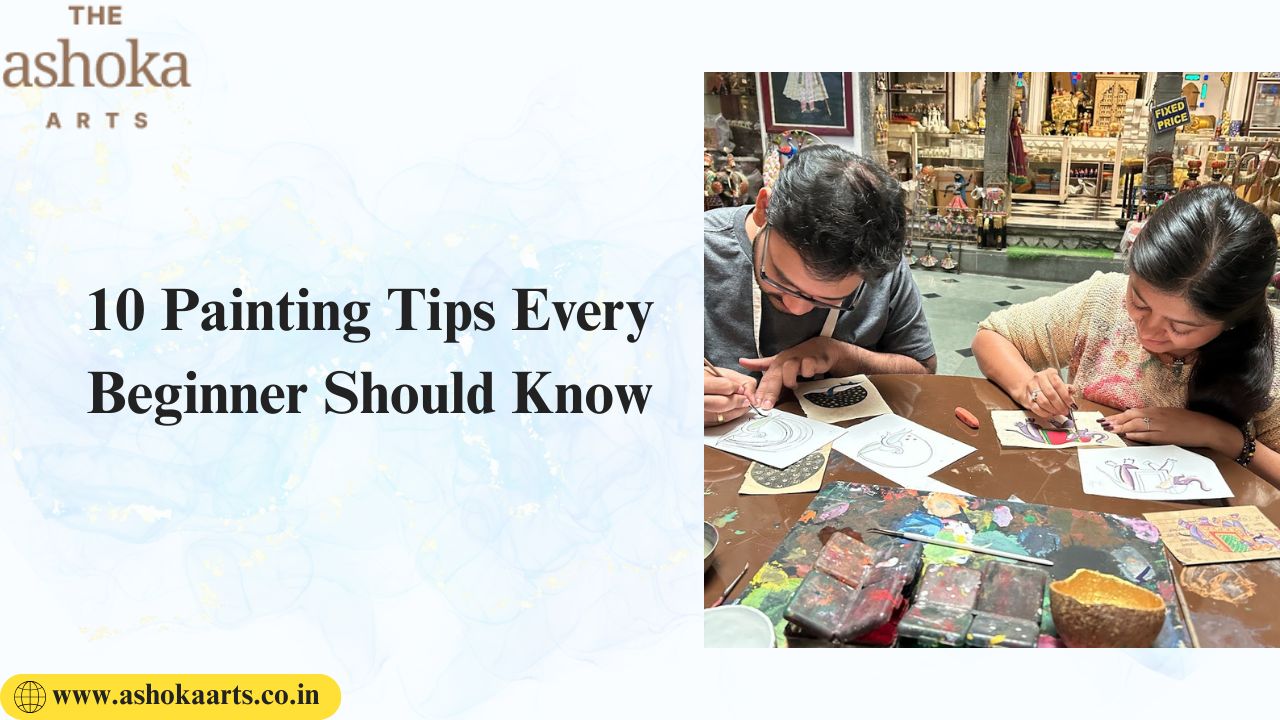
10 Painting Tips Every Beginner Should Know
Indian Miniature Painting refers to small-scale, detailed, and colorful paintings created originally on palm leaves, cloth, wood, and later on paper. Despite their small size, these paintings carry a great deal of beauty, intricacy, and cultural valorization. They generally either describe mythological events, royal courts, expressions of love, and nature.
Painting is the ultimate outlet for creative expression. You may well be dreaming of mastering Indian miniature painting, toying with the idea of working on Pichwai Cow Paintings, or just playing with colors on a canvas; knowing all the right techniques from the get-go can save a lot of wasted time, frustration, and materials.
If you have had the chance of traveling to Udaipur, you will realize that it feels like an art gallery being alive. The streets have handicrafts in Udaipur, colorful paintings, and shops such as Ashoka Arts famed for exquisite marble works and traditional paintings. Such care and craft can inspire any artist into higher levels of creation.
Here are 10 essential painting tips for you: both from the modern practice and traditions that are pretty ancient-so that your journey will be started with some confidence.
1. Invest in the Right Materials
Good tools won’t instantly make one a master, but they will surely help in the learning process.
In Indian miniature painting, artists use good squirrel-hair brushes and natural pigments to bring out rich detail. A beginner should select brushes that hold a solid shape and not change when wet, paints that give consistent color samples, and a paper that will not warp or canvas of some kind.
2. Understand the Art of Color Mixing
Knowing how to mix colors is another game-changer. Begin with the basics of primaries: red, yellow, and blue, then blend them to give secondary colors.
In handicrafts in Udaipur, from the works of art in Ashoka Arts, natural pigments are coupled with traditional binders to impart vibrant tones that last for recent ages. Do not overmix as this will do more harm to your colors; practice clean mixes done purposefully.
3. Observe Before You Paint
Before your brush touches the surface, take time to study your subject. This may include proportions, lighting, and details.
Artisans working on Pichwai Cow Painting often keep visual references on hand in the form of photographs and temple art to capture the sacred symbolism of the work, the gentle posture of the cows, and the decorative details that define the style.
4. Start Light and Build Up to Dark
No matter your medium, it’s easier to add depth by starting with lighter colors and then layering darker shades.
In traditional Indian miniature painting, an artist first applies a light base coat before adding details and darker outlines so that errors would not become permanent at a very early phase.
5. Practice Brush Control
Brush control is important for smooth lines and fine detail.
The making of marble articles at Ashoka Arts is considered an art, as the painted designs demand a steady hand and extreme precision. Practice with your brush, producing thin and thick lines by varying pressure.
6. Use Reference Images
Even experienced painters use references to keep proportions and details accurate.
If you are trying your hand at making a Pichwai Cow Painting, gather references of original works and studies from live animals. This is to ensure that your cows will appear somewhat realistic and yet retain the symbolic beauty of the style.
7. Design Your Background Thoughtfully
A well-planned background can elevate your main subject.
In Indian miniature paintings use courtyard spaces of palaces, gardens with floral borders, to narrate the story; Pichwai Cow Paintings take it further with lotus ponds, temple walls, and intricate foliage to complete the devotional theme.
8. Take Your Time with Details
Fine detailing is what makes traditional works—and your paintings—memorable.
The artisans who create handicrafts in Udaipur, including those at Ashoka Arts, work for days developing those exacting designs. As a newcomer, slow down and pay attention to details such as textures, ornaments, and facial expressions.
9. Turn Mistakes into Creative Additions
Every artist makes mistakes, but with a little creativity, you can turn them into unique features.
Sometimes, traditional craftsmen of Udaipur take an unexpected brush mark and end up incorporating that in new patterns or textures — a skill you should develop for yourself.
10. Keep Practicing
Painting mastery comes with consistent effort.
The masters of Indian Miniature Painting didn’t develop their skills overnight — they painted regularly, sharpening their techniques with each piece. Even small daily sketches will accelerate your growth.
Why Udaipur is an Artist’s Muse
Udaipur is a city that will always inspire you with its omnipresent artistic heritage. From the dynamic Handicrafts in Udaipur to the divine charm of Pichwai Cow Painting, artistry here is definitely a living example of patience, precision, and passion.
Shops like Ashoka Arts keep coming back with offerings of marble articles and paintings that meld tradition with timeless beauty. Their elegantly crafted products stand testament to how dedication to craft produces objects considered treasures for generations.
Final Thoughts
Be it intricate strokes of Indian miniature painting or detail-oriented Pichwai Cow Painting or marble articles of Sicilian genius by Ashoka Arts, Patience and regular practice, that is the real secret to any improvement.
Each tip above is a stepping stone toward becoming a confident painter. So pick up your brush, take inspiration from centuries of tradition, and start creating your own masterpiece today.